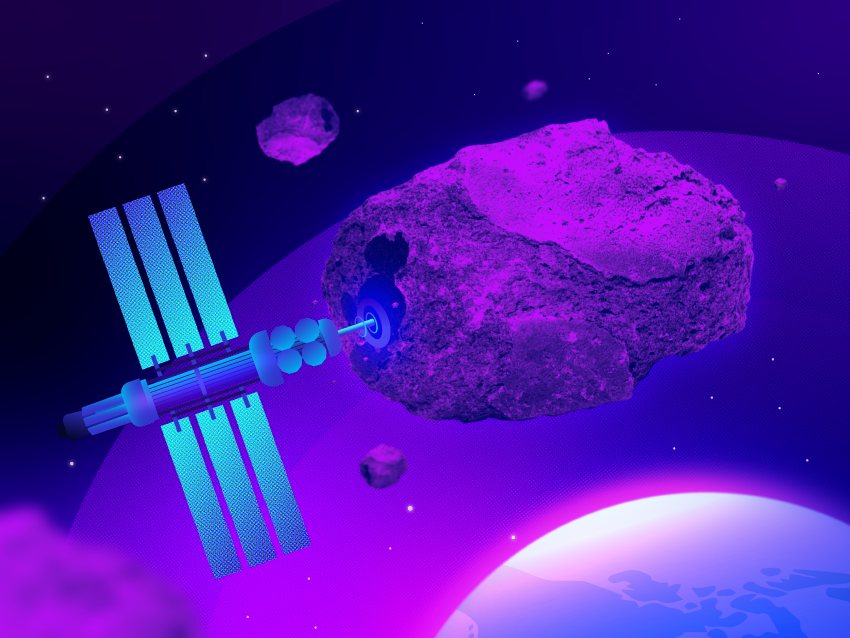Building an economy in space with asteroid mining
Posted: November 14, 2025

In 2023, NASA launched an unmanned mission to Asteroid 16 Psyche, which scientists used to think was the core of a planet destroyed long ago. With newer data emerging, however, scientists aren't as sure of its origin or composition. They hypothesize that the asteroid contains so much metal that on Earth, the minerals would be valued at an astonishing $10 quintillion—thousands of times greater than the entire global economy. Data from this latest mission could help scientists determine the figure's accuracy.
And this is just a single asteroid. The asteroid belt as a whole contains unfathomable wealth. Most of its value comes from concentrated deposits of platinum group metals, such as rhodium, which was valued at $200,000 per kilogram at the beginning of October.
Our Industrial Life
Get your bi-weekly newsletter sharing fresh perspectives on complicated issues, new technology, and open questions shaping our industrial world.
Platinum group metals (PGMs) are invaluable for green technology. Their rarity on Earth, in conjunction with increased demand, has led to their astronomical prices. The question is whether those valuable metals can be brought down to Earth at a low cost.
"Mining—separating ore from dirt—is relatively straightforward," says Ian Lange, Professor of Economics and Business at the Colorado School of Mines, "but then some kind of chemical or heat process, and gravity, [is] required to separate what we want from what we don't. Reproducing that in space is going to be much harder.” Lange cautions that the asteroid mining industry might have to develop entirely new methods.
Harsh temperatures, lack of gravity and the remoteness of asteroids are only a few of the challenges. But this hasn’t stopped companies like AstroForge, a space mining organization that hopes to make trillions by harvesting extraterrestrial PGM metals.
One successful proof of concept for asteroid mining came in 2023 when the NASA mission OSIRIS-REx recovered 122 grams of rock from the asteroid Bennu. Some believe that asteroid mining could be commercialized by simply scaling up technology similar to that used on the mission OSIRIS-Rex mission.
Skills and tools for space mining
In theory, asteroid mining works like this: A specialized spacecraft would launch into orbit, travel to a preselected PGM-rich asteroid, match its speed and rotation, attach itself with an anchor and begin to drill, capturing materials to bring back to Earth for processing.
But before startups like AstroForge can launch such a mission, they must first learn more about asteroids and what's in them. Scientists can get a good idea about what an asteroid is composed of by studying the way light bounces off it. To do this, they use spectroscopy tools that determine how reflective an asteroid is, for example. Higher reflectivity can indicate the presence of metal.
In addition, radar tools can help scientists construct 2D or 3D models of near-Earth asteroids and estimate both their rotational frequency and density. Impact sites—craters created by collisions—also offer valuable insight into asteroid composition.
Still, these tests only offer part of the picture. Bringing back surface material, as NASA’s did with its OSIRIS-REx mission and hopes to do again with 16 Psyche, is invaluable for teaching us more about asteroid composition.
This sort of data is particularly consequential for asteroid mining companies. To get investments, firms need to be more than fairly confident about whether a multi-million dollar mission is landing on an asteroid rich in PGMs.
Promising startups leading the space race
Based in California, AstroForge launched its first space module, Odin, in February 2025. It was the first company ever to receive a license to send a module into deep space.
Its mission was to rendezvous with a faraway asteroid and assess its composition with sensors. Unfortunately, Odin developed communication problems shortly after its launch, which have not yet been resolved.
AstroForge remains undaunted, however, and is planning a new mission, Vestri, which is scheduled to launch in 2026. Vestri’s goal is to collect data from a near-Earth, PGM-rich asteroid and potentially collect samples. If successful, AstroForge’s next step is to start harvesting significant amounts of metal.
Despite the challenges facing the startup, Victor Vescovo, one of AstroForge’s primary investors, remains confident in the project. He argues that it’s just a matter of developing the right tools. Once the company can recover a small amount of an asteroid’s contents, it can start scaling up projects for commercialization.
For AstroForge, successful commercialization means bringing one to two thousand kilograms of refined PGM metal back to Earth per mission—somewhere between $70 million and $140 million in metals per trip. The company plans to vaporize asteroid ore and use magnets to separate the metal out in space.
TransAstra, another notable pioneer in asteroid mining, has partnered with NASA to develop a kind of space mining technique called Optical Mining™ that forgoes the use of a drill. Instead, optical mining uses reflectors to create ultra-concentrated rays of sunlight powerful enough to break rock. In a demo that took place in southern New Mexico, the TransAstra team harnessed the sun to heat a small chamber to an estimated 3,500 degrees Fahrenheit (1,927 degrees Celsius). When the light and heat made contact with the rock sitting in the chamber, bits of rock flew off.
But Joel Sercel, the CEO of TransAstra, says that mining asteroids for PGMs to send back to Earth won't be cost-effective for some time. In the meantime, his company is focused on harvesting resources that enable space colonization and deep space exploration.
“I anticipate a massive gold rush to asteroid mining once the world figures this out,” says Sercel. “And the first actor is going to have a huge advantage that will give them a lasting leg up in space for decades and maybe centuries to come.”